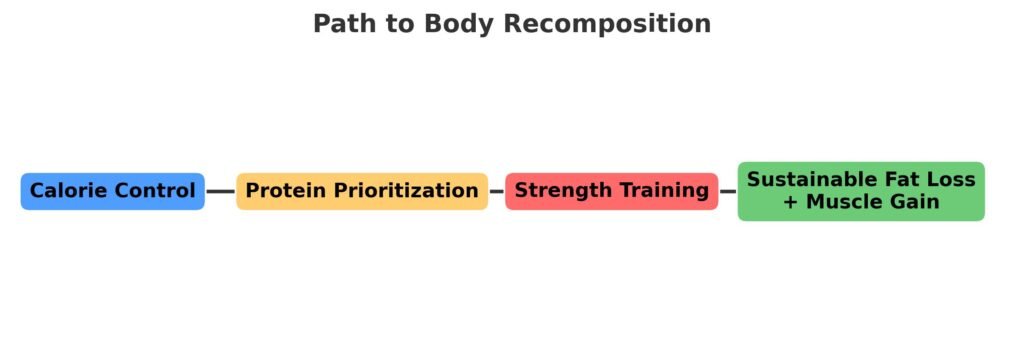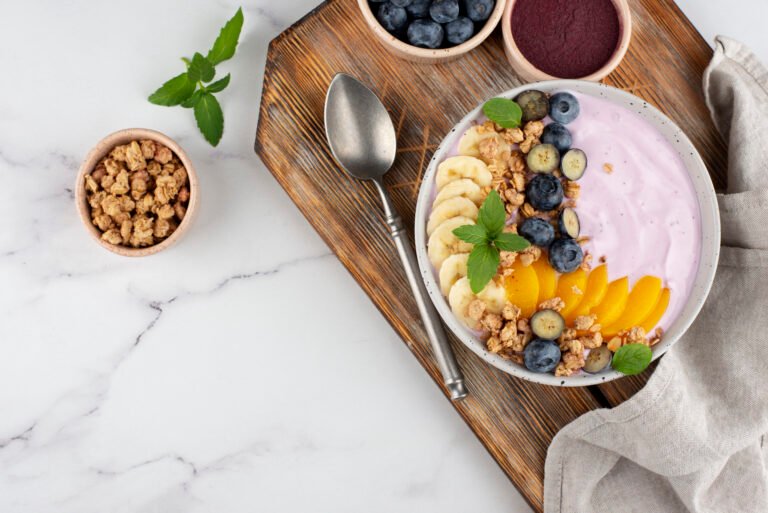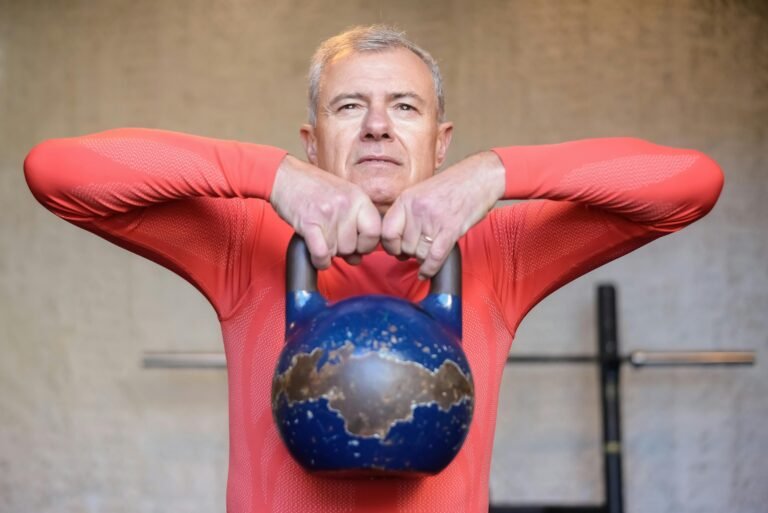How to Lose Fat and Gain Muscle with Nutrition: A Complete Guide
The Huberman Lab Podcast with Alan Aragon | August 28, 2025
For many people, the ultimate fitness goal isn’t just losing weight or building muscle—it’s achieving both at the same time. This process, known as body recomposition, is one of the most searched health and fitness topics on Google because it addresses the challenge of balancing two seemingly opposite goals: burning fat while building muscle.
The good news? It is possible. With the right nutrition, training, and recovery plan, you can reshape your body, improve your metabolism, and boost long-term health.
In this guide, we’ll break down the science of fat loss and muscle gain, explain the role of nutrition in detail, and give you practical, evidence-based strategies you can implement right away.

Nutrition: The Foundation of Fat Loss and Muscle Gain
Training builds the stimulus, but nutrition provides the raw materials for change. Without the right nutrients, you can’t recover properly or build new muscle tissue. Likewise, without controlling calories, fat loss is nearly impossible.
1. Energy Balance Matters—but Quality Is Key
To lose fat, you need to be in a calorie deficit. To gain muscle, you need enough nutrients to fuel recovery and growth. That sounds contradictory, but the balance lies in nutrient timing and macronutrient quality.
- Slight calorie deficit (200–500 kcal/day) works best for fat loss without sacrificing muscle.
- Prioritize protein-rich foods to maintain lean tissue.
- Fill the rest of your calories with whole-food carbs and healthy fats.
The important thing to remember is that calories are not all equal when it comes to performance and health. A diet made up mostly of refined foods may technically fit your calorie target, but it won’t give your muscles the amino acids and glycogen needed to recover from hard training. By contrast, a nutrient-dense diet ensures that your calorie deficit comes from stored body fat rather than from muscle.
Example: Instead of cutting 1,000 calories and losing both fat and muscle, reduce your intake moderately and focus on protein and resistance training to encourage fat loss while preserving strength.
2. Protein: The Cornerstone of Recomposition
Protein is the single most important macronutrient for body recomposition. It supports muscle repair, growth, and satiety (keeping you full). Without enough protein, you risk losing muscle mass even if you’re training hard.
- Recommended intake: 1.6–2.2 g of protein per kilogram of bodyweight daily.
- Spread intake across 3–5 meals per day, each containing 25–40 g of protein.
- Best sources: lean meats, fish, eggs, Greek yogurt, cottage cheese, tofu, tempeh, and protein powders.
One of the biggest myths is that your body can only “use” 20–30 grams of protein per meal. Research shows that muscle protein synthesis continues to respond to larger amounts, especially in people who train with intensity. This means it’s fine if you have one large protein-heavy meal—your body will still make use of it.
Real-life example: A 170-pound (77 kg) individual should aim for about 125–170 grams of protein daily, split into balanced meals. That could look like three eggs and Greek yogurt for breakfast, chicken and rice for lunch, a protein shake post-workout, and salmon with vegetables for dinner.
Takeaway: Hitting your protein target consistently is more important than obsessing over exact meal timing.
3. Carbohydrates: The Misunderstood Fuel
Carbs are often demonized in weight loss, but they are essential for performance and recovery. Your muscles rely on stored glycogen from carbs to push through resistance training. Without them, performance and recovery decline.
- Carbohydrates fuel strength training sessions that drive muscle growth.
- Post-workout carbs help replenish glycogen and speed up recovery.
- Opt for slow-digesting carbs like oats, brown rice, quinoa, sweet potatoes, beans, and fruits.
It’s important to distinguish between whole-food carbs and refined carbs. Eating whole grains, fruits, and vegetables provides vitamins, minerals, and fiber that support long-term health, while processed carbs like pastries or soda spike blood sugar without providing much nutrition. Carbs are not the enemy; overeating low-quality carbs is.
Mistake to avoid: Cutting out carbs completely often leads to poor energy, reduced training performance, and eventually muscle loss. A smarter strategy is to keep carbs in your diet but time them around workouts for optimal fuel.
4. Fats: Hormonal Health and Recovery
Healthy fats are crucial for hormone regulation, particularly testosterone and estrogen, which influence muscle growth and fat metabolism. They also provide fat-soluble vitamins like A, D, E, and K, all of which play a role in recovery and overall health.
- Sources: avocados, nuts, seeds, olive oil, fatty fish.
- Aim for at least 20–30% of daily calories from fat.
Another reason fats matter is satiety. Foods rich in healthy fats slow digestion, helping you stay full longer. They also give meals flavor and texture, making a fat-loss diet more enjoyable and sustainable.
Takeaway: Don’t go “zero fat”—your hormones and recovery will suffer, and hunger may increase, making fat loss harder.
Macronutrient Balance for Recomposition
Here’s an example macronutrient breakdown for a 2,200-calorie diet designed for fat loss with muscle gain:
Macronutrient | Target % of Calories | Grams (per day) | Example Foods |
Protein | 30–35% | 165–190 g | Chicken, fish, Greek yogurt, tofu |
Carbohydrates | 40–45% | 220–250 g | Rice, oats, fruits, beans |
Fats | 20–25% | 50–60 g | Olive oil, nuts, avocado, salmon |
This balance provides enough protein to preserve muscle, enough carbs to fuel workouts, and enough fat to maintain hormones. Notice that none of the macronutrients are eliminated—each plays a unique role in body recomposition.
Training & Nutrition Synergy
Nutrition is only part of the equation—strength training is non-negotiable. Without it, your body has no reason to hold onto muscle.
- Resistance training 3–5 times per week is ideal.
- Focus on compound lifts (squats, deadlifts, presses, rows, pull-ups).
- Mix in isolation exercises for balance.
- Include short bursts of high-intensity interval training (HIIT) for fat burning without excessive muscle loss.
Think of training as the “signal” and nutrition as the “building blocks.” If you don’t train, protein is just fuel. But when you lift weights, those amino acids are directed toward muscle repair and growth. Cardio has a role, but too much can interfere with recovery. A mix of resistance training and light-to-moderate cardio provides the best balance.
Real-life example: People who combine weight training with high protein intake consistently lose more fat and gain more lean muscle than those who only diet or only do cardio.

This simplified flow shows how each factor works together rather than in isolation. When you combine all three, body recomposition happens.
Common Myths About Fat Loss and Muscle Gain
1. “You can’t lose fat and build muscle at the same time.”
– False. With the right nutrition and training, recomposition is possible, especially for beginners and intermediates. In fact, it’s often the fastest way for new lifters to see visible progress.
2. “Carbs make you fat.”
– Carbs don’t inherently cause fat gain. Overeating calories does. In fact, carbs fuel the training required for muscle growth and support better recovery.
3. “Fasted training burns more fat.”
– Research shows no significant difference in fat loss between fasted and fed training when calories are controlled. Choose whichever feels better for your performance and lifestyle.
Takeaway: Most diet myths fall apart when you focus on total calories, protein intake, and training consistency.
Practical Tips for Success
- Track your food intake using apps like MyFitnessPal to stay aware of calories and macros.
- Prioritize strength training over excessive cardio.
- Sleep 7–9 hours per night—muscle growth happens during recovery, not just in the gym.
- Stay hydrated, aiming for at least 2–3 liters of water daily.
- Be patient—body recomposition takes months, not weeks.
Another useful strategy is to measure progress beyond the scale. Use progress photos, track your strength in the gym, and monitor how your clothes fit. These indicators often show improvement long before the scale moves significantly.
Real-Life Example: 12-Week Transformation
Sarah, a 32-year-old office worker, wanted to lose 15 pounds but also look toned. Instead of crash dieting, she followed these steps:
- Ate at a 300-calorie deficit with 150g protein daily.
- Trained with weights 4x per week.
- Included 2 sessions of HIIT cardio.
- Focused on whole foods and reduced added sugars.
After 12 weeks, Sarah lost 10 pounds of fat while gaining 3 pounds of lean muscle, visibly transforming her body composition. The best part? She didn’t feel deprived, and she learned how to enjoy foods like pizza or dessert in moderation without ruining progress.
Lesson: Small, sustainable changes consistently applied lead to better results than drastic dieting.
The Bigger Picture: Fitness and Longevity
Body recomposition isn’t just about looking lean—it’s about long-term health, strength, and metabolism. More muscle mass improves:
- Insulin sensitivity (reducing risk of type 2 diabetes).
- Bone density (lowering risk of osteoporosis).
- Resting metabolic rate, meaning you burn more calories even at rest.
Strong muscles also protect against injury and improve functional fitness, which becomes more important as we age. Instead of seeing fitness as a short-term goal, think of it as an investment in your future health. By focusing on balanced nutrition and strength training, you’re not just changing your body—you’re setting yourself up for decades of better health.
Final Thoughts
Achieving fat loss and muscle gain at the same time is challenging, but absolutely possible with the right approach.
- Eat in a slight calorie deficit.
- Prioritize protein and strength training.
- Use carbs and fats wisely to fuel recovery and hormones.
- Stay consistent, track progress, and be patient.
The result? A leaner, stronger, healthier version of yourself.
Related Post



